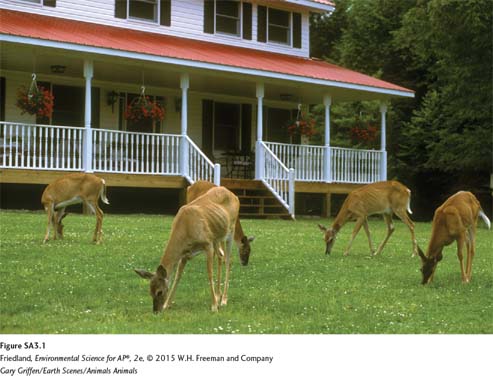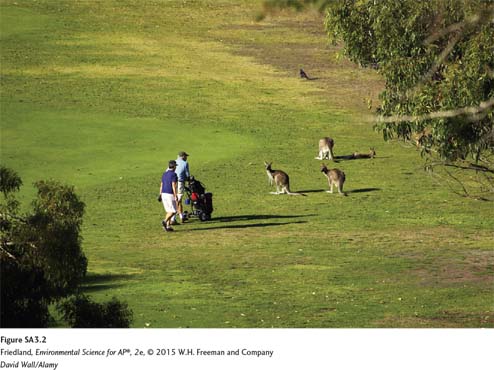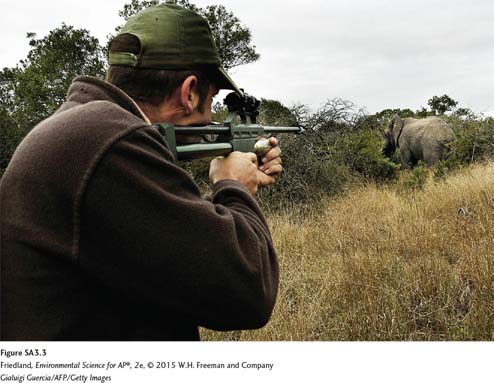202.1 3scienceapplied
255

How Can We Manage Overabundant Animal Populations?
The growing human population has caused population declines in many animal species, while, at the same time, other species have flourished as the result of human alterations of the landscape. Increases in the populations of these species have had many consequences. How have these increases happened, and what, if anything, should we do about them?
What causes animal population explosions?
The white-

This population growth can be explained by processes we discussed in Chapters 6 and 7. For example, white-
In addition to providing deer with habitat and food, humans have eliminated many of the deer’s major predators, including wolves and cougars. During much of the twentieth century, regulated hunting held deer populations in check, taking the place of natural predators that had largely been eliminated. Over the last few decades, however, the number of deer hunters has steadily declined, allowing the deer population to increase. In short, a higher carrying capacity and a lower mortality by both predators and hunters have allowed deer populations to grow exponentially and exceed their historic carrying capacity (FIGURE SA3.1).

The white-
256
Large herbivorous mammals are not the only animals that experience overpopulation as the result of human activity. Florida’s 500,000 monk parakeets (Myiopsitta monachus) are the offspring of individuals that have escaped from the pet trade since the 1960s. Other former pets, including dogs and cats, quickly establish feral populations when released into the wild. Populations of Canada geese (Branta canadensis) have grown along with the number of agricultural fields and golf courses on which they can feed.
What effects do overabundant species have on communities?
Populations that exceed their historic carrying capacity can cause widespread problems. Large populations of herbivore species such as deer, elephants, and kangaroos can overgraze the plants in their community, leaving little food for other herbivorous species. In Australia, grazing by the overabundant kangaroos removes many of the plants needed by other herbivores, including several species of endangered animals that depend on these plants for food and habitat.
These large animal populations also have direct effects on humans. Herbivorous mammals consume agricultural crops, landscape plants, and valuable wild plant species. In the United States, for example, the deer population so greatly exceeds the land’s natural carrying capacity that it is now difficult to regenerate several valuable forest tree species, including northern red oak (Quercus rubra) and sugar maple. Deer also consume suburban landscape plants and damage $60 million worth of agricultural crops each year.
Wildlife overabundance increases wildlife-
How can we control overabundant species?
Controlling the population of any species involves issues that are ecological, political, moral, and ethical. From an ecological perspective, it is clear how to control a wildlife population: reduce the available food and habitat to lower the carrying capacity, compensate for the missing predators by killing individuals in the population, or slow the population’s ability to reproduce. On a local scale, it can be helpful to discourage people from feeding wildlife. On a larger scale, however, reducing food and habitat is often the least viable option because it would typically require restricting the access of large herbivores to millions of hectares of land.
In 2009, the Australian government ordered the army to shoot 6,000 kangaroos as a way to reduce the population of 9,000 kangaroos living on a large military compound. The objective was to reduce the amount of grazing done by the kangaroo herd and therefore protect rare plants and the insects that live on those plants. Culling the kangaroo population on the military compound was a controversial decision that was opposed by animal rights activists and by many Australians who consider the kangaroo a national symbol that should be protected. The activists obtained a court injunction to stop the culling of the species, but after a delay, the kangaroo cull proceeded. Throughout the world, even when all parties agree that the overabundance of a species poses major problems for humans and for the environment, culling a herd through shooting is an increasingly unpopular strategy.

257
A strategy that has more public support is the use of birth control. This approach is common in cities, where many feral cats are trapped, neutered, and returned to the wild. Researchers are also investigating ways to give animals contraceptive drugs in order to reduce their populations over time. The drugs being developed differ in their modes of action, ranging from chemicals that prevent animals from making critical reproductive hormones to chemicals that prevent sperm from fertilizing an egg. Contraceptive strategies are currently being tested on a variety of species, including deer, kangaroos, elephants, and monk parakeets (FIGURE SA3.3).
Reducing animal overpopulation with contraceptives has widespread public appeal because it eliminates the need to kill animals. Getting the contraceptive drugs into the animals, however, presents substantial challenges. Drugs can be administered to some animals via dart guns. For others, such as monk parakeets, researchers are working on ways to administer medications in food. Some contraceptive drugs last for a single breeding season and require a new dose each season, which can be difficult and expensive. The cost of giving an animal a single dose of a contraceptive drug ranges from $100 to $500 per animal.
The issue of overabundant wildlife highlights a number of other environmental issues. The underlying causes of animal overpopulation are typically associated with human population increases. These human-
Questions
Question 202.1
1. If humans are responsible for environmental changes that cause increases in the populations of native species, under what conditions should we work to reverse these population increases?
Question 202.2
2. How might the options to control overabundant populations differ in rural versus urban areas?
Free-
List three density-
dependent factors and three density- independent factors that can influence the population size of white- tailed deer. (2 points) Describe two ways that deer populations at low abundance can accelerate the process of ecological succession in a forest toward a climax stage. (4 points)
Consider a region of temperate forest that contains 100,000 deer with a sex ratio of 3 females to 1 male, an infant mortality rate of 10, a crude birth rate of 40, and a crude death rate of 20. Only 10 percent of the females are able to reproduce.
Calculate population growth rate for white-
tailed deer in this region. (2 points) Calculate the number of deer that hunters would need to shoot in order to keep the deer population stable. (2 points)
References
Broache, A. 2005. Oh deer! Smithsonian, October.
New York Times. 2004. Putting nature on the pill. August 31. (http:/
New York Times. 2008. Australia stirs controversy over a plan to cull 400 kangaroos. March 14. (http:/
New York Times. 2013. A kinder, gentler way to thin the deer herd. July 5. (http:/